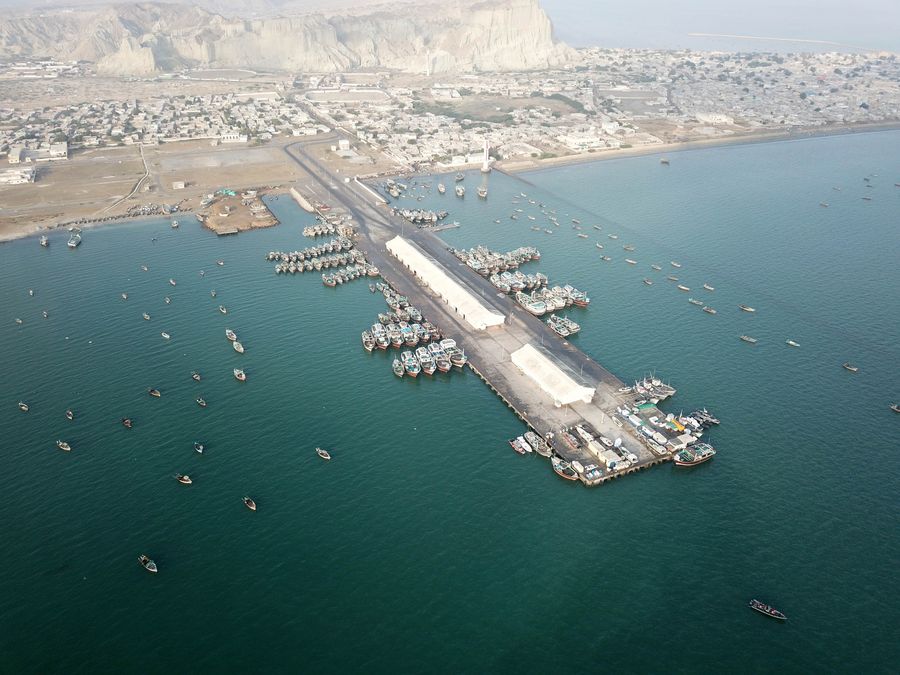

Gwadar is the future hub of commercial activities. It will change traditional trade routes and patterns. New trading partners will emerge and will bring prosperity to the entire region. Gwadar will prove to be "a port of the future."
Gwadar is the deepest seaport in the world, situated on the Arabian Sea at the entrance of the strait of Hurmuz, through which 70% of the world’s oil and gas passes. The Middle East meets 70% of the world’s demand for energy. In return, the Middle East is the largest destination of global exports of all major industrial and agricultural nations. The region depends heavily on imports, relying on them for almost everything. The oil and gas-rich nations spend lavishly and import almost all luxury products from the developed world.

Fishing boats berth in the bay at Gwadar port in southwest Pakistan's Gwadar, Jan. 29, 2018. (Xinhua/Ahmad Kamal)
Gwadar is considered a mega project under the Belt and Road Initiative. It is about 170 kilometers to the east of Chabahar Port in Iran, and 385 kilometers from Muscat in Oman, and only 700 kilometers from UAE. Its strategic location will make a difference in future geopolitics.
Gwadar's potential as a deepwater seaport was first noted in 1954, and development work was inaugurated by Pervez Musharraf in 2007. In 2015, it was declared that the city and port would be further developed under CPEC at the cost of $1.62 billion to link northern Pakistan and western China to the deepwater harbor. The port will also be the location for a much-needed floating imported-liquefied natural gas facility built as part of the massive $2.5 billion Gwadar-Nawabshah segment of the imported-gas pipeline project.
Building and development began in June 2016 on the Gwadar Special Economic Zone, which is being built on a 2,292-acre site adjacent to Gwadar's port. China has shown an interest in developing it on the same lines as Shenzhen. China was successful in turning this small fishing village into a dynamic metropolis. Based on Shenzhen's experience, it is believed that Gwadar will develop just as quickly.
The government of Pakistan has introduced incentive-based flexible policies to make Gwadar an international freeport. Gwadar Port became formally operational on Nov.14, 2016, when it was inaugurated by Pakistan's Prime Minister Muhammad Nawaz Sharif, and the first convoy was seen off by Pakistan's then Chief of Army Staff, General Raheel Sharif. On Jan. 14, 2020, Pakistan made Gwadar Port operational for the Afghan transit trade.
Gwadar is the deepest port in the world, with 150 berths, connecting China, Central Asia, East Asia, South Asia, Eurasia and Russia with warm waters on the Arabian Sea, which will provide unlimited opportunities for the whole region in their journey toward prosperity. It also connects Africa and Europe.
Although China is developing the Gwadar port, many other countries have agreed to invest in Gwadar, including Russia, Saudi Arabia, UAE, Kuwait, Qatar, Japan, South Korea, Malaysia, Iran, Turkey, and some European countries.
The Western part of China bordering Pakistan is Xinjiang Uygur Autonomous Region, whose GDP is 1.36 trillion yuan. This robust economy bordering Pakistan is an added blessing.
The opinions expressed in this article belong solely to the author, and not necessarily to People's Daily Online.
Zamir Ahmed Awan is a senior fellow with the Center for China and Globalization (CCG) and a sinologist at the National University of Sciences and Technology in Pakistan.
He can be reached at awanzamir@yahoo.com
 Fire brigade in Shanghai holds group wedding
Fire brigade in Shanghai holds group wedding Tourists enjoy ice sculptures in Datan Town, north China
Tourists enjoy ice sculptures in Datan Town, north China Sunset scenery of Dayan Pagoda in Xi'an
Sunset scenery of Dayan Pagoda in Xi'an Tourists have fun at scenic spot in Nanlong Town, NW China
Tourists have fun at scenic spot in Nanlong Town, NW China Harbin attracts tourists by making best use of ice in winter
Harbin attracts tourists by making best use of ice in winter In pics: FIS Alpine Ski Women's World Cup Slalom
In pics: FIS Alpine Ski Women's World Cup Slalom Black-necked cranes rest at reservoir in Lhunzhub County, Lhasa
Black-necked cranes rest at reservoir in Lhunzhub County, Lhasa China's FAST telescope will be available to foreign scientists in April
China's FAST telescope will be available to foreign scientists in April "She power" plays indispensable role in poverty alleviation
"She power" plays indispensable role in poverty alleviation Top 10 world news events of People's Daily in 2020
Top 10 world news events of People's Daily in 2020 Top 10 China news events of People's Daily in 2020
Top 10 China news events of People's Daily in 2020 Top 10 media buzzwords of 2020
Top 10 media buzzwords of 2020 Year-ender:10 major tourism stories of 2020
Year-ender:10 major tourism stories of 2020 No interference in Venezuelan issues
No interference in Venezuelan issues
 Biz prepares for trade spat
Biz prepares for trade spat
 Broadcasting Continent
Broadcasting Continent Australia wins Chinese CEOs as US loses
Australia wins Chinese CEOs as US loses